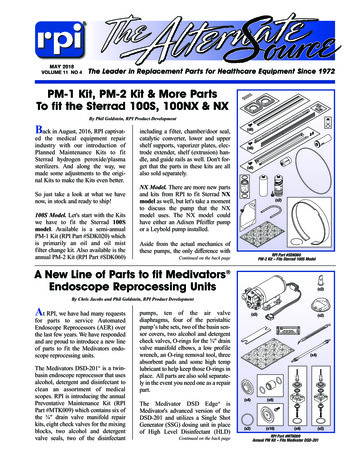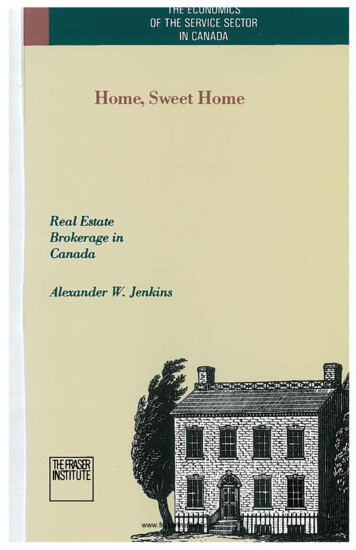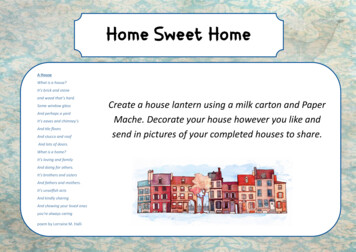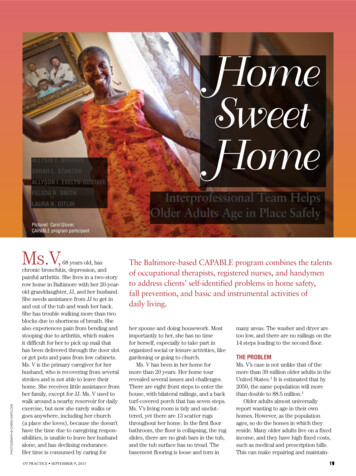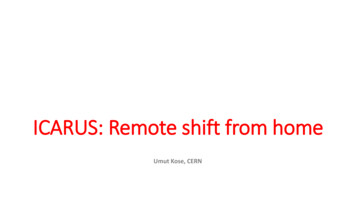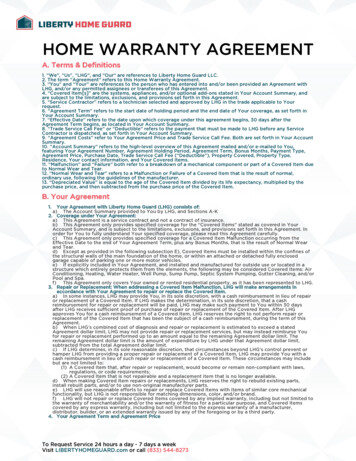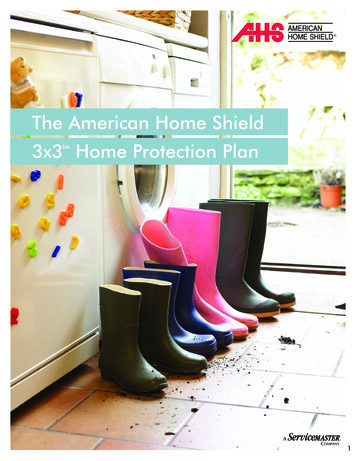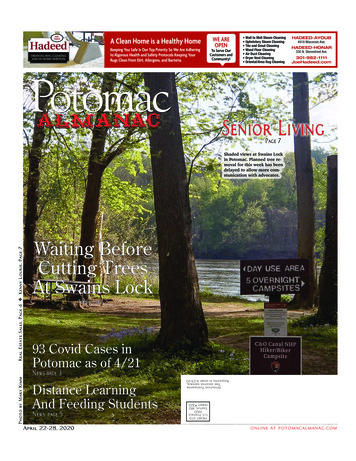Transcription
Numicon At Home KitActivity Bookfor Key Stage 1 (P2–P3)2
Contents1Introduction3Before you get started4What’s in the box6Finding how many by grouping7Halves and quarters of wholes8Recall of adding and subtracting facts within 1092-digit numbers and more ordering10Using the and symbols13Finding possibilities162-digit numbers19Exploring different patterns21Adding and writing adding sentences23Subtracting and writing subtracting sentences24Odd and even26Rounding27Comparing and ordering numbers to 10029Numicon At Home Kit Activity Book for Key Stage 1 Oxford University Press 2020Great Clarendon Street, Oxford OX2 6DPOxford University Press is a department of theUniversity of Oxford. It furthers the University’s objective ofexcellence in research, scholarship, and education by publishingworldwide. Oxford is a registered trade mark of OxfordUniversity Press in the UK and in certain other countries. Oxford University Press 2020First published 2020These activities are based on activities from Numicon Number,Pattern and Calculating 1 Teaching Resource Handbook andNumicon Number, Pattern and Calculating 2 Teaching ResourceHandbook.All rights reserved. No part of this publication may bereproduced, stored in a retrieval system, or transmitted in anyform or by any means, without prior permission in writingof Oxford University Press, or as expressly permitted bylaw, by licence or under terms agreed with the appropriatereprographics rights organization. Enquiries concerningreproduction outside the scope of the above should be sentto the Rights Department, Oxford University Press, at theaddress above.You must not circulate this work in any other form andyou must impose this same condition on any acquirer.ISBN: 978-0-19-837519-7Supporting maths teaching withinspirational resources, adviceand professional development2
Numicon at Home Kit for Key Stage 1 (P2–P3) childrenThis kit is designed for children and parents to enjoy learning about numbers, pattern and calculating at home. For 5–7 year olds.The Numicon approach is designed to help your childsee connections between numbers and number ideasChildren are usually very quick to notice patterns.Spotting and working with patterns is essential at alllevels of mathematics.The pattern in the Numicon Shapes helps children seethe connections between numbers and to have a deepunderstanding of number ideas and calculation.The connections your child sees will provide a firmfoundation for their mathematics understanding –particularly their mastery of mental arithmeticand early calculation.The approach supports the early maths teaching yourchild will be meeting in school in Year 1 and Year 2The practical activities in this book have been speciallychosen to illustrate key mathematical ideas that youcan share and enjoy with your children at home, tobuild up your children’s mathematical understanding.In this kit children will meet the big ideas of placevalue and equivalence. A secure understanding ofthese ideas is fundamental to all their later mathswork. The Numicon approach encourages all childrento visualize numbers and understand numberrelationships.The Numicon approach is multi-sensoryNotesYour child will learn through both seeing and feelinghow Numicon Shape patterns connect with eachother. By physically building constructions, makingarrangements and patterns with Numicon Shapesand playing games with the feely bag, your childwill experience both with their hands and eyes hownumbers fit together and start to really understandhow we use numbers in our calculations.Although the activities at first glance may seemsimple, through them children are meeting importantmathematical ideas which lay the foundation for alltheir later understanding of number. These key ideasare explained briefly in the notes on each page.Numicon Shapes follow a systemYou will see that the holes in the Numicon Shapesare arranged to correspond to the numbers 1 to 10.The pattern of holes for each number follows thesame basic system of arranging holes ‘in pairs’. Sowhen Numicon Shapes are arranged in order, childrencan begin to notice important connections betweennumbers – that each number is ‘one more’ than thelast, and ‘one fewer’ than the next, for example. Yourchild will be able to see with Numicon Shapes how twofours make eight, and three twos make six, etc. Lateron your children will be able to visualize the numberfacts to ten which then support adding in groupsof ten.Numicon At Home Kit Activity Book for Key Stage 1 Oxford University Press 2020LanguageThe mathematical language that your child can learnthrough each activity is signalled. It is importantthat you try to encourage the children to use thislanguage as they are engaging in the activities. What’simportant here is that children are learning to usefamiliar words such as ‘take away’ in a mathematicalcontext, where the meaning may be subtly different.To check the meaning of maths words or terms youmight not be familiar with, go to the Owl Mathseducation glossary.3
Before you get startedThe activities in this kit offer the potential for you to give a firm foundation to your child’s understanding ofnumber pattern, place value and early calculating. However, to get the most from this kit please take a fewmoments to read the guidance below.The Numicon approach is part of your child’s widerexperience with numbersIt is important that your child has plenty ofexperience of and talk about maths such as counting,understanding number and the foundations ofcalculating alongside his or her play with the Numiconactivities. Encourage your child to count anything andeverything around him or her, including the holes inNumicon Shapes. Draw your child’s attention to allthe written numerals in the world around us – housenumbers, page numbers, telephone numbers, roadsigns, birthday cards, sports scores, etc.Children learn effectively by being involved and‘doing’ mathematicsIt is important not to try to rush your child through theNumicon activities in this pack. A slow approachis preferable in order to achieve secure understandingand firm foundations for later work.In fact it is always helpful to be prepared to let yourchild experiment and to let them make up their owngames. Encourage your child to talk about what theyare doing, ask them to explain their thinking, can theywork out answers in a different way? If your child isengrossed in his or her experiments with the Numiconresources, then you can be sure your child is learningsomething valuable.Show by exampleWhen you want to introduce your child to a newactivity, show by your own example. Be seen to beinterested and involved yourself. You can begin theactivity and then let your child carry on or take overas they work out what you are doing. Teachers callthis ‘modelling’.Don’t put pressure on your child to advance tooquickly; let them enjoy repeating the things theyhave learned over and over. Try not to let any concernof yours for your child’s success create unhelpfulpressure as this can put them off. We all enjoyrepeating things we do well, and children are noexception – celebrate their successes and encouragethem to repeat these often.Numicon At Home Kit Activity Book for Key Stage 1 Oxford University Press 2020TensOnes2 tens and 6 ones26twenty six4
Let your child play with the Numicon Shapesindependently, as well as gradually followingthe teaching activitiesIf an activity is fun and engaging it will help topromote positive emotions and if the activity isworked on as a family group it will promote positivefamily relationships, both of which are essential forwell-being. The activities in this kit build on the workthey will have been doing at school and that you aresupporting your child with their learning.On the following pages you will find several differentteaching activities (games!) for you to follow withyour child using the materials provided. There is morethan a whole year’s activity here. Your child will alsoenjoy playing with the resources independently andthis type of exploratory play is important. Throughtheir independent play children gain confidence andfamiliarity that will be important for themas activities become more advanced.The activities in this kit offer the potential for you togive a firm foundation to your child’s understanding ofnumber, number pattern and calculation. However, toget the most from this kit please take a few momentsto read the guidance below.Work through the stages of activities in orderAllowing plenty of time for your child’s independentplay, work through the various stages of activities onthe cards gradually, in order. Allow your child plentyof time to become confident with the type of activityon each card before moving on – repeating successes,over and over again, is very important for children’sfeelings of confidence and mastery over their world.Encourage your child to develop a mental pictureof the Numicon ShapesThe Numicon Shapes offer children a visual pictureof numbers and their relationships. Playing someactivities by touch encourages children to developmental imagery. It is helpful to say to your child ‘letyour fingers be your eyes’ and ‘try to see the NumiconShapes in your mind’s eye’.Help your child to count, as wellCounting things (anything and everything) is a veryimportant accompaniment to these activities. Countwith your child to begin with, and then graduallyallow him or her to take over the counting more andmore – your child learns from your example. Ask ‘Howmany of these do we have?’ frequently, and graduallyencourage counting of bigger and bigger collections.Keep the Zig-Zag Book on viewThe Numicon Zig-Zag book is a very importantbackground tool for continuing your child’s work withthe Numicon activities. It is double-sided with thenumber line on one side and the counting book onthe other. The groups of objects in the counting bookare linked to the appropriate Numicon Shape. Thebook should also be on display, close by and availablewhenever your child is working on Numicon activitieswith you. Best of all, the Numicon Zig-Zag Bookshould be kept with the collection of all your child’sother books.Numicon At Home Kit Activity Book for Key Stage 1 Oxford University Press 20205
What’s in the boxThe PegsThe 52 Pegs come in only four colours, becausechildren need to move beyond matching only bycolour. The Pegs are useful for making patterns bothby threading them onto the Threading Lace, or byarranging them on the Baseboard.They can also be fitted into the holes of the NumiconShapes and used to build number towers.The Numeral CardsThe Numicon Shapes32 in total. These are designed to represent numberideas and how numbers relate to one another, in a waynot provided by written numerals.The Baseboard and OverlaysThe 10 10 Baseboard, designed to hold the NumiconShapes and Pegs, is used in many activities. The PictureOverlays fit on the Baseboard to make four differentmatching puzzles.The 0–10 laminated Numeral Cards are used in lateractivities once children are familiar with the NumiconShapes.The Zig-Zag BookThis plays an important part in your child’s work withNumicon. You will see that it is a counting book onone side and on the other there is what teachers call a‘number line’.The Feely BagImportant in our multi-sensory approach! Whenchildren ‘feel’ for a ‘number’ in the bag, they have tovisualize Numicon Shape patterns, an important stepin developing their own mental imagery of numbers.Numicon At Home Kit Activity Book for Key Stage 1 Oxford University Press 20206
Finding how many by groupingNotesAs your child works through these activities, theyActivity 1: Let’s find out how manyby grouping objectsActivity 2: Finding how many 1p coins by groupingand counting in tenswill build the patterns for the Numicon Shapes to Show a collection of up to 30 small objects to Show your child the container and tip outfirmly establish that grouping is an efficient way tofind out ‘how many’. Their counting, estimating andunderstanding of place value is supported by thestructure of the Numicon Shapes.They will begin to understand that in our numbersystem we can group in tens. This is important for laternumber work they will do at school.Have ready Numicon Shapes or Printable Numiconyour child.the 1p coins.1 Ask if they can guess how many items there are.Don’t count at this stage, just estimate. Ask how many coins there might be in the container. Ask your child how they can find out how many Ask how they can find out how many there are(e.g. counting in ones, twos, fives etc.)coins there are. Encourage them to group the money into tens. Encourage your child to group in tens.1p coins fit very nicely over the holes in a Match each group with Numicon Shapes.2 Finally, agree how many there are, say the numberand write the number.10-shape.3 Finally, agree the amount, say the number and writethe number. How does the total compare with their estimate? How close was their estimate?Shapes, printed and cut out(link to printable Numicon Shapes) Numicon Pegs Numeral Cards A group of items: for example, seashells, buttons,cars or pasta shells2 A container of 1p coins (no more than 40)Mathematical language3Count, how many, number names to 100, check,estimate, tens, ones, twos, fives, group, pattern,1numeral14Numicon At Home Kit Activity Book for Key Stage 1 Oxford University Press 20201p1p 1p 1p1p 1p 1p1p1p1p 1p1p 1p1p 1p 1p1p1p1p 1p 1p1p1p 1p 1p1p1p1p1p1p1p1p1p1p1p1p1p1p1p1p1p1p1p1p1p207
Halves and quarters of wholesNotesActivity 1: Halving collections of objectsThese activities will build on your child’s everyday Show your child a collection of ten Pegs.Activity 2: Cutting sandwiches into halves andquartersexperiences of partitioning wholes into halves and Ask what you could do so you each get half Ask your child to prepare a sandwich.quarters, like sharing a cake between two people ora chocolate bar between four. It is essential childrenexperience f
Numicon At Home Kit Activity Book for Key Stage 1 Oxford University Press 2020 5 Let your child play with the Numicon Shapes independently, as well as gradually following feelings of confidence and mastery over their world. the teaching activities If an activity is fun and engaging it will help to promote positive emotions and if the activity is

